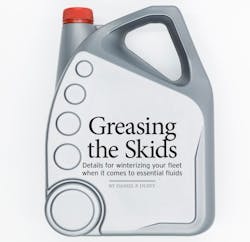Direct labor costs, material costs, and equipment operating costs are the trinity of any contractor's balance sheet. Often not included are overhead costs such as the care and maintenance of equipment which don't often get applied directly to a particular project but have a deceive impact on a contractor's bottom line. Chief among these overhead costs involve the care and maintenance of equipment hydraulic systems, oils, and lubricants. Each requires a particular fluid and operating delivery system to keep heavy equipment functioning. And these fluid systems need to be maintained, especially during the winter when the equipment is not being used. So, a contractor's fleet of heavy equipment has to be "winterized" each year. This requires specific procedures for backhoes, dozers, loaders, excavators, and trucks, with some pieces of equipment needed additional attention.
Winterizing an Equipment Fleet for Either Operations or Storage
Heavy earthmoving equipment does not typically operate during winter weather. There are several reasons for this. First off, engines like it hot, not cold. Even low viscosity oils become thick when temperatures fall below freezing. Batteries generate lower voltages with decreased temperatures making equipment start-up problematic. Cold can generate condensation that accumulates in the equipment's fuel, with diesel fuel being especially vulnerable to the formation of insoluble crystals. Engine coolant system fluids are affected by the cold. All types of hydraulic hoses and tubes can crack in the cold due to brittleness. Tire pressures drop with falling temps and tracked equipment can see mud, snow and ice accumulate on the undercarriage. Cold can cause exterior finishes and paint to chip and crack. Seals become less secure. And operations can become particularly unsafe with snow hiding ground obstacles, with mud and ice reducing traction.
All in all, winter operations require extensive preparation to ensure safety and productivity. Such preparation and forethought are necessary for the operation of equipment when temperatures fall below freezing, equipment that normally runs temperate, or hot temperatures the other three seasons.
First, operators need to switch out their standard hydraulic fluids and engine oil for hydraulic fluids and oils with light or ultra-light viscosities. Cold temperatures cause normal viscosity hydraulic fluids to "coagulate", making it thicker and more difficult to pump. And the type of pump used is key to determining the necessary fluid or oil viscosity. Both are rated in relation to their applicable engine pump system. Viscosity is defined as a fluid's internal residence to flow and shear. Viscosity ratings usually apply to a temperature range between 40°C (104°F) to 100°C (212°F). Viscosity is measured in centistokes (1 square millimeter per second). These values are translated into industry-standard ratings designated by their ISO number or grading (ISO VG 32, 46, and 68). Peak operations under standard conditions typically viscosities 10 and 100 centistokes.
Each type of equipment has its own unique hydraulic system configuration:
Crawler excavators are tractor tread-mounted machines that require at least six different types of hydraulic actuators: boom arm extension, bucket arm lift, bucket tilt and lift, arm swing left and right, travel left, and travel right. This is a complicated array of functions and requires special demands on its hydraulic system. During operations, a crawler excavator's hydraulic system conducts all of this movement more or less simultaneously, Multiple functions require large-volume flows of hydraulic fluids will be required to ensure efficient operations responsive to the commands of the operator. Management of these hydraulic fluid flows is accomplished with differential cylinders with hydraulic flow rates that are twice the installed pump displacement volume.
The excavator's drive system should be able to convert 100% of its engine output into hydraulic power. The resultant hydrostatic power will be much higher than the engine's maximum output. The goal is to have each movement's volume flow optimized. Due to economic reasons, the number of pump circuits (which can be expensive) should be limited. Therefore, movement optimization is achieved by combining or separating pump circuits. Independent movement is accomplished by tuning the hydraulic flows through control valves, although more advanced systems utilize software and sensor technology) GPS guidance, laser guidance, etc.). Newer hydraulic control systems also employ intelligent electric systems and electronics.
Specialized equipment utilizes different job-specific hydraulic system configurations. For example, skid loaders and front-end loaders also depend on hydraulics. But these are more bulk material handlers than a true excavator or earth mover. The oversized (relative to the equipment body) front-end bucket requires three pairs of hydraulic pistons for operation. The first pair raises and lowers the bucket. The second pair vertically tilts and rotates the bucket to allow loading and dumping. The third pair can split the bucket and allow it to grab objects like boulders, structural members or logs.
The hydraulic system configuration for a dump truck is much simpler. Dump trucks typically have no more than one or two large hydraulic cylinders whose job is to raise and lower the truck bed. But these hydraulic cylinders have a couple of unique design features. To allow for long movement length they telescope in multiple segments too. To be able to lift heavy loads, these cylinders also tend to be more powerful.
Why is this important for nonstandard (winter) operating conditions? The thicker the fluid, the harder a pump has to work. A pump's energy output has to increase to match the increased density/weight of the fluid and the high friction force it generates with the walls of hose and tubes and within the pump itself. The result is additional mechanical stress on the pump, wear and tear on its parts, and increased energy supply requirement—all of which can increase the temperature of the pump while in operation. This temperature can have over time a warping effect on pump parts such as impellers, toothed gears, connections and seals. This same increased wear and tear can also damage valves, cylinders, and pumps. Hydrocarbon fluids (oil, hydraulic fluid, lube) are long-chain molecules (polymers). The longer the polymer chain, the more highly viscous the liquid is. Synthetic hydrocarbon fluids can have unique, customized molecular structures to fit their applications, all long-chain polymers are subject to breakdown after extended cold periods.
As mentioned above, the same cold temperature problems affect engine oil as well as hydraulic fluids. Again, increased viscosity requires the oil pump to work harder, subjecting it to accelerate wear and tear. Furthermore, thicker oil with its increased weight and friction along the walls of tubes and hoses takes a longer time to circulates through the oil system back to the oil reservoir. It then becomes less efficient at absorbing and dissipating engine waste heat. As such, the engine performance and efficiency suffer. At the very least, cold engine oil reduces engine fuel efficiency, increasing operating costs. The worst-case scenario is damage to the engine’s pistons and warping of its cylinders becomes accelerated, resulting in expensive repairs or even engine block replacement.
Not normally considered to be hydrocarbon fluids so much as hydrocarbon fuels, gasoline and diesel fuels, as well as engine coolant, are negatively affected by extreme cold. Gelling of fuels can occur, necessitating the use of anti-gel fuel additives to stabilize the fuel during very cold operating conditions. These anti-gel additives also prevent icing and fuel line freeze up, and the formation of ice layers within the fuel filters. Above ground tank storage of POLs (petroleum, oil, lubricant) needs to be modified to project the tanks and their contents from extreme cold in addition to anti-cold additives in the stored fluids. The potential for icing in the fuel can be easily reduced by the simple task of topping off the gas tank in winter to eliminate space where ice formation can occur.
But most equipment operators don't work during wintertime, preferring to put their equipment into winter storage rather than expose their expensive investments to the potential damages described above and to avoid increased operating costs resulting from winterization. This equipment simply isn't parked somewhere until spring. Heavy equipment has to be prepared for storage until the start of the next construction season.
This process involves several steps. First, the operator performs a thorough inspection of the machine as a whole and all of its important moving parts from the hydraulic cylinders to the cab door hinges. This is a thorough and methodical visual inspection of the fluid application points as well as pressure/temperature meter readings of the fluid reservoirs and actuators. In addition to the fluid itself, the inspection should look for any worn parts indicating a failure of the current fluid system. Repairs and maintenance should be scheduled accordingly.
Following the inspection and maintenance work, the equipment should receive a complete lube job and seal points to ensure that water and ice cannot intrude during winter storage. In contrast to the use of low viscosity fluids during winter operations, lubes used for winter storage should be thicker, high-viscosity lubes that won’t drip off the equipment and will maintain complete coverage for the winter.
Next, the equipment should receive a complete oil change, replacing the standard oil with low viscosity winter-grade engine oil. A new oil filter, no matter how much the old filter was used during the previous construction season, should also be installed. Along with the oil change, anti-freeze/coolant should be added to the engine's coolant system. This new anti-freeze will prevent the engine from experiencing ice build-up while it sits cold and idle over the long winter. All such additions and change-outs should be in strict conformance with the supplier's and manufacturer's specifications and recommendations.
Lastly, detach and separately store all equipment attachments (blades, arms, excavator buckets, loader buckets, etc.). The battery should be pulled and stored separately in a climate-controlled storage building that protects the batteries from cold temperature degradation. Keep thorough records of all winter storage procedures and storage locations, finally throwing a large tarp over the equipment and securing it in place until next spring.
Last but not least is the most important “piece of equipment” on the job site—the human operator. Those performing winter storage procedures should be thoroughly trained in the requirements of this operation. These are expensive investments that can be needlessly damaged if storage procedures are not properly carried out. If being operated during the winter months, the equipment operators will need special training for winter conditions and winter safety requirements. Maintenance crews will be busier during winter months with more frequent maintenance cycles as well as different operating parameters, along with unique safety requirements when performing maintenance or repairs out in the field.
While focusing on the mechanical aspects of winter operations, the human element should not be ignored. Maintenance crews need to be well versed on the more extensive maintenance schedules and associated safety problems that come with cold weather. Operators need to be trained in moving and working their equipment in potentially adverse ground conditions and being cognizant of the proper cold weather operating parameters for their equipment.

